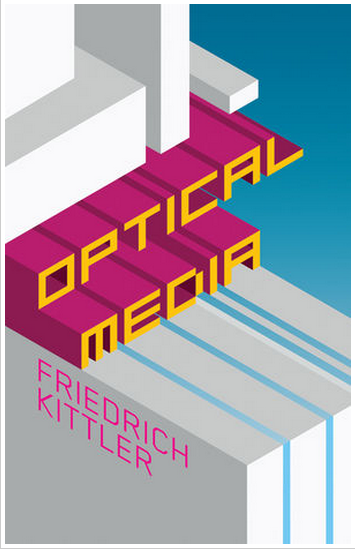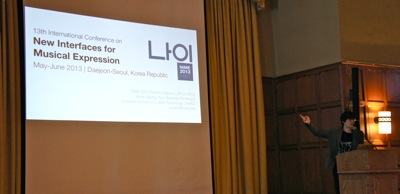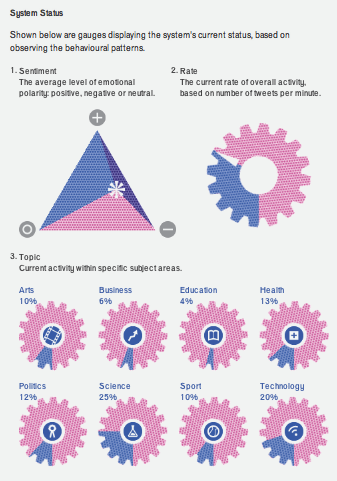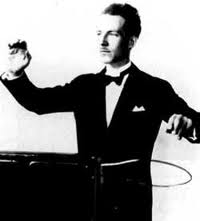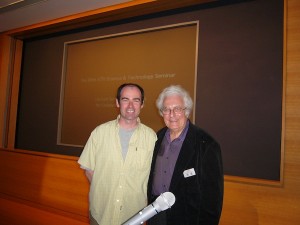Here’s another book I enjoyed reading this summer, Friedrich Kittler’s Optical Media. The original German version dates back to 2002, but the English translation did not appear until two or three years ago. I was surprised at just how much the general outlook and some of the content overlaps with my introductory course in digital media. What could I possibly have in common with Kittler, who had a background in German literature? One point of overlap is an interest in Marshall McLuhan’s work. Kittler also seems to have explored information theory to a certain extent though he sometimes understandably shows gaps in his understanding of the scientific basis of media technology. Nonetheless, this work provides valuable perspective on the history of image media technology.
Category Archives: Research
NIME-13 @ KAIST
Last week at NIME-12, Professor Woon Seung Yeo (aka Woony) made the official announcement that Korea will host NIME-13. The conference will be held at the “MIT of Korea”, KAIST (Korea Advanced Institute of Science and Technology) in Daejeon, with an extra day in Seoul for cultural events and club concerts.
I gave a talk at KAIST in 1998 as part of an invited trip to Korea as keynote speaker at the annual meeting of the Korean Cognitive Science Society. KAIST is about one hour from Seoul by express train.
Sonifying Tweets: The Listening Machine
Via: http://www.thelisteningmachine.org/
The Listening Machine
by Daniel Jones and Peter Gregson
The Listening Machine is an automated system that generates a continuous piece of music based on the activity of 500 Twitter users around the United Kingdom. Their conversations, thoughts and feelings are translated into musical patterns in real time, which you can tune in to at any point through any web-connected device.
It is running from May until October 2012 on The Space, the new on-demand digital arts channel from the BBC and Arts Council England. The piece will continue to develop and grow over time, adjusting its responses to social patterns and generating subtly new musical output.
The Listening Machine was created by Daniel Jones, Peter Gregson and Britten Sinfonia.
See also: The Listening Machine Converts 500 People’s Tweets into Music (Wired)
Kugelschwung – Pendulum-based Live Music Sampler
Kugelschwung is the result of a second year Human Computer Interaction project by six Computer Science students at the University of Bristol. These students should be roughly the same age as students in our seminar. The interface is simple but works very well and the concept is brilliant. The work has been accepted for presentation at NIME-12.
The Dunning–Kruger Effect
Something worth reflecting upon as an educator: The Dunning–Kruger effect. Paraphrasing the Wikipedia entry, this is a cognitive bias by which the unskilled mistakenly overestimate their competence. The article gives two excellent historical quotes recognizing the effect:
“Ignorance more frequently begets confidence than does knowledge” (Charles Darwin)
“One of the painful things about our time is that those who feel certainty are stupid, and those with any imagination and understanding are filled with doubt and indecision”
(Bertrand Russell)
This effect is named after two Cornell psychologists who verified it experimentally. Dunning and Kruger also described the converse effect by which the actually competent may suffer lower confidence.
The article quotes cross-cultural studies which claim to show the effect may be less significant, even inverted, with East Asians, however this runs counter to intuition and my personal experience with Japanese university students. Ignorance of one’s own ignorance seems to be intrinsic to the nature of knowledge. Consider the ancient aphorism of Lao Tzu:
He who knows does not speak.
He who speaks does not know.
Having some experience with cross-cultural experimentation, I am acutely aware of the difficulties of conducting carefully controlled, unbiased experiments, as well as the dangers of over-generalizing results out of context. Perhaps it is the social presentation of self-perceived competence that differs between Western and East Asian subjects – something like the ‘Display Rules’ for facial expressions discussed Paul Ekman et al..
VR and the Computer of the 21st Century
I want to make note of a powerfully brilliant paragraph from a highly influential article [1] by Marc Weiser published in September, 1991:
Perhaps most diametrically opposed to our vision is the notion of virtual reality, which attempts to make a world inside the computer. Users don special goggles that project an artificial scene onto their eyes; they wear gloves or even bodysuits that sense their motions and gestures so that they can move about and manipulate virtual objects. Although it may have its purpose in allowing people to explore realms otherwise inaccessible – the insides of cells, he surfaces of distant planets, the information web of data bases – virtually reality is only a map, not a territory. It excludes desks, offices, other people not wearing goggles and bodysuits, weather, trees, walks, the infinite richness of the universe. Virtual reality focuses an enormous apparatus on simulating the world rather than on invisibly enhancing the world that already exists.
It is perhaps superfluous to say that Mark Weiser and his colleagues at Xerox PARC were prescient and that, comparatively speaking, things have gone in the direction of ubiquitous computing, rather than virtual reality. And perhaps this is not surprising, many of the brightest and most interesting human interface researchers were at PARC from about the early 70’s onward. Their work made the future we now see in the largely usable, mobile, embedded, sensor-laden socially-networked devices of recent times.
[1] Mark Weiser, The Computer for the 21st Century, Scientific American 265(3): 94-104 (1991).
Gmail Tap
Project Glass @ Google

Google has posted information about Project Glass. The photos and video show a stylish, lightweight eyeworn see-through display operated via a speech interface, which allows you to do many of the things you already do with your iPhone, but without manual interaction. This announcement has been expected for some time and we mentioned it in an earlier post on HMDs titled Retro-Future. It will be increasingly difficult to justify the purchase of outrageously priced and bulky retro-HMDs when consumer products with superior form-factor and functionality come on to the market. Currently price estimates for the AR eyewear run from $200.00 to $600.00, but this is guessing. No doubt Google will make APIs easily available for the eyewear, so that R&D can be conducted by anyone with modest means and sufficient motivation. The video, available via YouTube, is probably mostly a mock-up and I’m wondering where the battery will be located.
The First NIME
The BBC News web site currently has a good article about the Theremin, an electronic instrument invented by Russian Léon Theremin in 1919. Though it was not the first synthesizer, I consider the Theremin to have been the first NIME: earlier electronic synthesizers like the Telharmonium (1897) mainly used keyboard-like controllers. The Theremin, by contrast, is played with non-contact gestures (waving your hands in the air). It is a full blown new electronic instrument, the product of a futurist/modernist outlook and cutting-edge technical mastery (for the day), which opened the potential for completely new forms of human artistic expression.
I am not going to introduce the Theremin here. Better to start by reading the BBC article or Wikipedia entry, both linked above. You can get an idea of how it can be played by watching any number of videos on YouTube. Here’s Léon Theremin’s neice, Lydia Kavina, playing Claude Debussy’s “Clair de Lune”:
The BBC article quotes an interesting statement from Theremin biographer Albert Glinsky which I would like to include here:
RCA felt this was going to replace the parlour piano and anyone who could wave their hands in the air or whistle a tune could make music in their home with this device. The Theremin went on sale in September 1929 at the relatively high price of $220 – a radio set cost about $30. It was also much more difficult to play than the advertising claimed. And just one month later came the Wall Street Crash. You took it home and found that your best efforts led to squealing and moaning sounds. So the combination of the fact that only the most skilled people could teach themselves how to play it and the fact that there was a downturn in the economy meant that the instrument really wasn’t a commercial success
This seems to be a somewhat common story with the most unusual/innovative new music technology – it is difficult to get make significant cultural impact.

The Theremin, however, has had good staying power. It is still a niche instrument with few virtuosi, but you can, in fact, purchase a Theremin and find someone to help you to learn how to make music with it. High quality Theremins are made by Moog Music. As it turns out, electronic instrument pioneer Robert Moog got started by selling Theremin kits while he was still an undergraduate physics student. Moog represents an important link between the earliest NIMEs and contemporary electronic music technology and culture. For this reason we invited Dr. Moog as a Keynote speaker for NIME-04, which was held in Hamamatsu, Japan’s mecca for music technology.
I had the good fortune to invite Dr. Moog to give a talk at the company where I used to work, ATR, in southern Kyoto prefecture. It was a great experience to spend time talking with Dr. Moog and to introduce him to a huge and enthusiastic audience who showed up from all over Japan to hear him speak. I will never forget what a kind-hearted person Bob Moog was.
Joseph Beuys in Ubud, Bali
It has been seven years since I was on the magical island of Bali. So magical that I managed to capture the voice of Joseph Beuys while doing some field recordings in the rice paddies surrounding Ubud:
(A note of thanks to Ableton, Leonardo of Pisa (aka Fibonacci) and, not least, Ubudweb.

